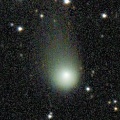
|
Now it is bright as 10.2 mag (May 7, Carlos Labordena). The brightness evolution is slower than originally expected. It is expected to be observable at 7 mag for a long time from 2022 to 2023. In the Northern Hemisphere, it stays observable in good condition until autumn. However, it is not observable at the high light from autumn to 2023 summer. In the Southern Hemisphere, it stays observable in good condition for a long time.
Date(TT) R.A. (2000) Decl. Delta r Elong. m1 Best Time(A, h)
May 14 18 42.69 11 15.6 2.538 3.193 122 9.3 3:17 ( 0, 66)
May 21 18 35.94 10 45.8 2.395 3.130 128 9.1 2:43 ( 0, 66)
|
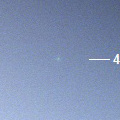
|
Appearing in the evening sky. Now it is very bright as 7.2 mag (May 1Mike Olason). The condition is very bad in this apparition. It is observable only in the extremely low sky from mid May to mid July in the Northern Hemisphere, or from early June to early August in the Southern Hemisphere.
Date(TT) R.A. (2000) Decl. Delta r Elong. m1 Best Time(A, h)
May 14 4 51.05 23 8.7 1.505 0.672 21 10.3 20:33 (118, 1)
May 21 5 39.66 24 31.9 1.526 0.756 25 11.1 20:41 (118, 4)
|

|
Now it is 10.1 mag (May 4, Osamu Miyazaki). It will be getting lower after this. In the Northern Hemisphere, it will be unobservable in May. In the Southern Hemisphere, it stays observable until July.
Date(TT) R.A. (2000) Decl. Delta r Elong. m1 Best Time(A, h)
May 14 7 15.11 11 13.7 4.190 3.730 56 10.6 20:33 ( 89, 22)
May 21 7 21.74 10 21.8 4.289 3.750 51 10.7 20:41 ( 92, 15)
|
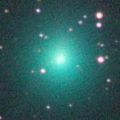
|
It brightened very rapidly up to 9.3 mag in March (Mar. 24, Michael Jager). Now it is not observable. In the Southern Hemisphere, it is appearing in the morning sky. It stays observable in good condition after this. In the Northern Hemisphere, it will never be observable again.
Date(TT) R.A. (2000) Decl. Delta r Elong. m1 Best Time(A, h)
May 14 2 20.64 6 33.3 2.085 1.177 19 11.0 3:19 (250,-15)
May 21 2 32.51 3 14.4 2.080 1.242 25 11.5 3:12 (254,-16)
|
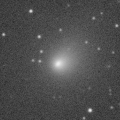
|
Now it is very bright as 9.8 mag (May 6, Marco Goiato). It stays bright as 10-11 mag from spring to summer. In the Southen Hemisphere, it stays observable in good condition for a long time after this. In the Northern Hemisphere, it is hardly observable after this.
Date(TT) R.A. (2000) Decl. Delta r Elong. m1 Best Time(A, h)
May 14 22 2.44 -57 3.3 1.342 1.816 100 11.2 3:19 (335,-11)
May 21 22 31.67 -65 42.2 1.263 1.800 104 11.1 3:12 (340,-18)
|
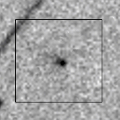
|
Now it is 11.8 mag (May 6, Chris Wyatt). In the Northern Hemisphere, it stays extremely low until spring. In the Southern Hemisphere, it stays observable at 11 mag until June.
Date(TT) R.A. (2000) Decl. Delta r Elong. m1 Best Time(A, h)
May 14 23 28.73 -4 45.2 1.870 1.656 61 11.3 3:19 (285, 13)
May 21 23 44.57 -3 23.3 1.846 1.681 64 11.4 3:12 (285, 14)
|
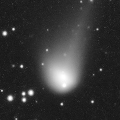
|
Now it is bright as 12.3 mag (May 6, Chris Wyatt). It stays observable at 11-12 mag until July.
Date(TT) R.A. (2000) Decl. Delta r Elong. m1 Best Time(A, h)
May 14 11 44.41 -11 53.8 3.559 4.248 127 11.6 20:33 ( 6, 43)
May 21 11 45.50 -10 33.7 3.639 4.245 120 11.6 20:41 ( 17, 43)
|
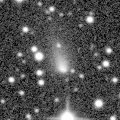
|
Now it is bright as 12.7 mag (May 2, Michael Jager). It is expected to brighten up to 9-10 mag in summer. In the Northern Hemisphere, it stays observable in good condition until June when it brightens up to 10 mag. But it is not observable after the high light. In the Souther Hemisphere, it is not observable until October.
Date(TT) R.A. (2000) Decl. Delta r Elong. m1 Best Time(A, h)
May 14 4 41.27 58 52.1 2.221 1.633 42 12.0 20:33 (149, 21)
May 21 5 21.42 57 42.6 2.167 1.556 41 11.7 20:41 (147, 20)
|
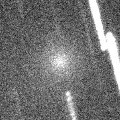
|
It was expected to brighten up to 4 mag, but the comet was disintegrated around the perihelion passage. In the Southern Hemisphere, it was observable in the extremely low sky in mid April. But it was not detected, fainter than 9.0 mag (Apr. 21, Michael Mattiazzo). In the Northern Hemisphere, it is appearing in the evening sky. Now it is very faint and diffuse, 12.7 mag (May 12, Michael Jager). It stays observable in good condition after this while the comet will be fading. In the Southern Hemisphere, it is not observable until August.
Date(TT) R.A. (2000) Decl. Delta r Elong. m1 Best Time(A, h)
May 14 4 25.57 61 11.6 0.622 0.711 44 12.2 20:33 (153, 21)
May 21 5 41.15 75 25.5 0.698 0.864 57 13.5 20:41 (164, 31)
|
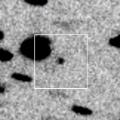
|
Now it is 13.2 mag (May 4, Thomas Lehmann). It stays 12-13 mag for a while. It is observable in excellent condition in the Southern Hemisphere. It locates low until May in the Northern Hemisphere.
Date(TT) R.A. (2000) Decl. Delta r Elong. m1 Best Time(A, h)
May 14 22 5.56 -20 28.5 1.411 1.688 86 12.6 3:19 (311, 17)
May 21 22 19.27 -20 14.6 1.379 1.715 90 12.7 3:12 (312, 18)
|
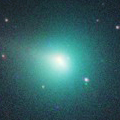
|
Now it is bright as 10.4 mag (May 4, Osamu Miyazaki). It will be fading after this. But it may stay brighter than this ephemeris for a while. In the Northern Hemisphere, it stays observable in excellent condition for a long time. In the Southern Hemisphere, it stays extremely low after this.
Date(TT) R.A. (2000) Decl. Delta r Elong. m1 Best Time(A, h)
May 14 7 6.10 43 1.3 2.161 1.748 52 12.7 20:33 (122, 34)
May 21 7 31.37 42 44.6 2.246 1.797 51 13.0 20:41 (122, 32)
|

|
Now it is 13.7 mag (May 14, Giuseppe Pappa). It will brighten up to 12.5 mag in summer. In the Southern Hemisphere, it stays observable in excellent condition for a long time. In the Northern Hemisphere, it is not observable until August.
Date(TT) R.A. (2000) Decl. Delta r Elong. m1 Best Time(A, h)
May 14 22 36.95 -57 13.1 2.943 3.207 95 13.4 3:19 (332,-14)
May 21 22 28.23 -58 25.9 2.811 3.181 102 13.3 3:12 (335,-13)
|
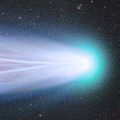
|
It brightened up to 3 mag from mid December to late December. Now it is fading. It has already faded down to 12.2 mag (Apr. 2, Thomas Lehmann). It is observable in good condition in the Southern Hemisphere. It is getting observable again also in the Northern Hemisphere.
Date(TT) R.A. (2000) Decl. Delta r Elong. m1 Best Time(A, h)
May 14 19 29.16 -39 3.3 1.660 2.370 123 13.3 3:19 (351, 15)
May 21 19 3.01 -39 8.3 1.647 2.464 134 13.5 3:11 ( 0, 16)
|

|
Now it is 14.2 mag (May 4, Thomas Lehmann). It will brighten up to 13 mag in summer.
Date(TT) R.A. (2000) Decl. Delta r Elong. m1 Best Time(A, h)
May 14 19 9.82 -28 27.7 2.332 3.052 127 13.6 3:19 (354, 26)
May 21 19 9.86 -28 54.3 2.258 3.049 133 13.5 3:12 (359, 26)
|

|
Now it is 14.9 mag (May 6, Chris Wyatt). It was expected to brighten up to 13 mag in spring. But actually, it is fainter than this ephemeris recently. In the Southern Hemisphere, it stays observable in good condition for a long time. In the Northern Hemisphere, it is not observable until autumn.
Date(TT) R.A. (2000) Decl. Delta r Elong. m1 Best Time(A, h)
May 14 6 28.96 -47 19.7 3.201 3.151 78 13.5 20:33 ( 46,-21)
May 21 6 29.01 -45 31.6 3.252 3.144 74 13.5 20:41 ( 51,-25)
|
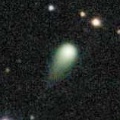
|
Now it is 13.3 mag (May 2, Michael Jager). It is expected to brighten up to 10 mag in 2023. In the Northern Hemisphere, it stays observable in good condition until 2023 autumn. In the Southern Hemipshere, it stays unobservable until 2023 summer.
Date(TT) R.A. (2000) Decl. Delta r Elong. m1 Best Time(A, h)
May 14 10 11.20 60 6.5 4.480 4.417 79 13.7 20:33 (153, 59)
May 21 10 4.41 59 27.9 4.518 4.360 74 13.7 20:41 (146, 55)
|
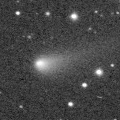
|
Now it is 13.8 mag (May 6, Chris Wyatt). It is observable at 13 mag in good condition until early summer.
Date(TT) R.A. (2000) Decl. Delta r Elong. m1 Best Time(A, h)
May 14 9 52.69 15 0.1 1.962 2.243 92 13.7 20:33 ( 63, 55)
May 21 10 1.01 14 2.0 2.030 2.233 87 13.8 20:41 ( 69, 49)
|
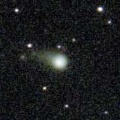
|
Now it is 13.8 mag (May 4, Hirohisa Sato). It is expected to brighten up to 12 mag in 2023. In the Northern Hemisphere, it stays observable in good condition for a long time. In the Southern Hemisphere, it locates extremely low in 2022, but it will be observable in good condition in 2023.
Date(TT) R.A. (2000) Decl. Delta r Elong. m1 Best Time(A, h)
May 14 14 59.85 43 35.3 4.039 4.597 117 13.8 23:30 (180, 82)
May 21 14 46.28 43 9.3 4.038 4.560 115 13.8 22:49 (180, 82)
|
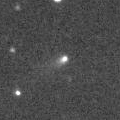
|
Now it is 15.9 mag (May 13, Giuseppe Pappa). It is expected to brighten up to 11 mag from summer to autumn. However, it is fainter than this ephemeris recently. It stays observable in good condition in the Southern Hemisphere. In the Northern Hemisphere, it becomes extremely low from August to September.
Date(TT) R.A. (2000) Decl. Delta r Elong. m1 Best Time(A, h)
May 14 9 47.28 27 4.2 1.387 1.674 87 14.1 20:33 ( 83, 60)
May 21 9 53.68 25 40.1 1.395 1.610 82 13.8 20:41 ( 86, 54)
|
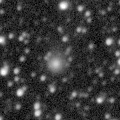
|
Now it is 14.3 mag (May 6, Chris Wyatt). It is expected to brighten up to 11 mag in 2023. In the Northern Hemisphere, it stays observable in good condition until November. But it becomes unobservable after that. In the Southern Hemisphere, it stays observable in good condition after this.
Date(TT) R.A. (2000) Decl. Delta r Elong. m1 Best Time(A, h)
May 14 18 52.98 18 58.8 4.040 4.575 116 14.0 3:19 (353, 74)
May 21 18 48.42 18 51.7 3.919 4.530 121 13.8 2:56 ( 0, 74)
|

|
Now it is 16.7 mag (Apr. 30, Jean-Francois Soulier). In the Southern Hemisphere, it is already not observable. It will be unobservable soon also in the Northern Hemisphere.
Date(TT) R.A. (2000) Decl. Delta r Elong. m1 Best Time(A, h)
May 14 5 8.41 29 9.0 6.872 5.985 26 14.0 20:33 (121, 7)
May 21 5 14.43 29 10.7 6.919 5.987 21 14.0 20:41 (125, 2)
|
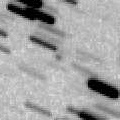
|
It is expected to brighten up to 13.5 mag in early summer. In the Southern Hemisphere, it is appearing in the morning sky. It stays observable in good condition after this. In the Northern Hemisphere, it is not observable at all.
Date(TT) R.A. (2000) Decl. Delta r Elong. m1 Best Time(A, h)
May 14 2 39.07 -16 38.0 1.967 1.305 36 14.6 3:19 (268,-32)
May 21 2 52.41 -19 39.8 1.833 1.278 42 14.4 3:12 (272,-33)
|

|
It approaches to Sun down to 0.14 a.u. on May 15. But it is not observable around that time. In the Northern Hemisphere, it will appear in the morning sky at 16 mag in June. It is hardly observable in the Southern Hemisphere.
Date(TT) R.A. (2000) Decl. Delta r Elong. m1 Best Time(A, h)
May 14 3 45.18 16 25.6 0.898 0.149 5 16.3 20:33 (125,-17)
May 21 2 43.92 20 51.1 0.989 0.270 15 14.5 3:12 (239, -7)
|
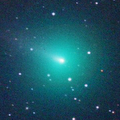
|
It brightened very rapidly up to 9.2 mag in winter (Jan. 31, Chris Wyatt). Now it is fading. It has already faded down to 14.7 mag (May 3, Chris Wyatt). It will be fainter than 18 mag in July.
Date(TT) R.A. (2000) Decl. Delta r Elong. m1 Best Time(A, h)
May 14 9 2.90 12 41.1 1.700 1.846 81 14.7 20:33 ( 72, 44)
May 21 9 19.03 11 50.7 1.822 1.905 78 15.1 20:41 ( 75, 40)
|
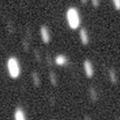
|
Now it is 15.1 mag (May 4, Hirohisa Sato). It will approach to Earth down to 0.29 a.u. in 2023 February, and it is expected to brighten up to 5 mag. In the Northern Hemisphere, it stays observable in excellent condition. In the Southern Hemisphere, it becomes unobservable from late September to early February.
Date(TT) R.A. (2000) Decl. Delta r Elong. m1 Best Time(A, h)
May 14 20 9.12 16 53.1 3.179 3.516 101 15.0 3:19 (308, 64)
May 21 20 4.81 18 58.3 3.016 3.440 106 14.8 3:12 (316, 69)
|

|
Now it is 15.7 mag (May 1, Thomas Lehmann). It stays at 15-16 mag for a long time. In the Southern Hemisphere, it stays observable in excellent condition for a long time. In the Northern Hemiphere, it locates extremely low in spring.
Date(TT) R.A. (2000) Decl. Delta r Elong. m1 Best Time(A, h)
May 14 16 17.42 -49 13.8 4.327 5.206 147 14.8 0:54 ( 0, 6)
May 21 16 4.90 -49 54.8 4.320 5.221 150 14.9 0:14 ( 0, 5)
|

|
It brightened up to 12.3 mag from spring to summer in 2021 (June 15, 2021, Marco Goiato). Now it is fading. It has already faded down to 14.9 mag (May 2, Michael Jager).
Date(TT) R.A. (2000) Decl. Delta r Elong. m1 Best Time(A, h)
May 14 12 25.95 31 37.1 4.363 4.869 114 15.3 20:57 ( 0, 87)
May 21 12 19.47 31 49.3 4.509 4.912 107 15.4 20:41 ( 49, 85)
|

|
Now it is 16.5 mag (Apr. 13, ATLAS-HKO, Haleakala). It will brighten up to 11.5 mag in 2022 winter. It stays observable while the comet will be brightening slowly.
Date(TT) R.A. (2000) Decl. Delta r Elong. m1 Best Time(A, h)
May 14 5 0.50 20 52.3 3.414 2.517 23 15.8 20:33 (116, 0)
May 21 5 13.30 21 13.1 3.406 2.476 19 15.7 20:41 (119, -3)
|
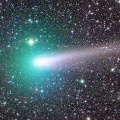
|
It brightened up to 8.5 mag from autumn to winter (Dec. 2, Toshihiko Ikemura, Hirohisa Sato). Now it is fading. It has already faded down to 15.9 mag (May 4, Catalina Sky Survey). It stays observable in good condition for a long time.
Date(TT) R.A. (2000) Decl. Delta r Elong. m1 Best Time(A, h)
May 14 9 32.63 18 1.6 2.262 2.425 86 15.8 20:33 ( 72, 53)
May 21 9 41.63 17 5.4 2.400 2.478 82 16.1 20:41 ( 76, 47)
|
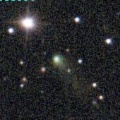
|
Now it is 15.8 mag (May 8, Thomas Lehmann). It stays observable at 16 mag from 2021 to 2022.
Date(TT) R.A. (2000) Decl. Delta r Elong. m1 Best Time(A, h)
May 14 15 58.12 39 59.0 4.432 5.026 120 15.9 0:33 (180, 85)
May 21 15 53.09 40 58.8 4.478 5.046 118 15.9 0:01 (180, 84)
|
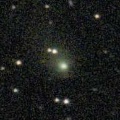
|
It became brighter after the perihelion passage, and it brightened up to 13.4 mag in early 2022 (Jan. 7, Hiroshi Abe). Now it is fading. It has already faded down to 15.4 mag (May 3, Chris Wyatt). It will be fainter than 18 mag in summer.
Date(TT) R.A. (2000) Decl. Delta r Elong. m1 Best Time(A, h)
May 14 10 28.03 3 27.2 3.585 3.960 104 16.1 20:33 ( 40, 52)
May 21 10 25.49 2 40.7 3.744 4.003 97 16.2 20:41 ( 51, 45)
|

|
Now it is 17.9 mag (May 11, Giuseppe Pappa). It was expected to be observable at 16 mag in good condition in spring. But actually, it is fainter than predicted by 2-3 mag.
Date(TT) R.A. (2000) Decl. Delta r Elong. m1 Best Time(A, h)
May 14 20 57.39 -10 4.9 0.986 1.518 98 16.2 3:19 (319, 35)
May 21 21 6.27 -7 6.1 0.966 1.544 102 16.3 3:12 (320, 39)
|
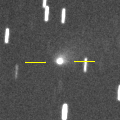
|
It continued brightening even after the perihelion passage, and it brightened up to 15.2 mag (Feb. 16, Ken-ichi Kadota). Now it is fading. It has already faded down to 17.5 mag (May 1, Catalina Sky Survey). It will be fainter than 18 mag in July.
Date(TT) R.A. (2000) Decl. Delta r Elong. m1 Best Time(A, h)
May 14 10 49.69 7 4.3 2.147 2.643 108 16.3 20:33 ( 34, 58)
May 21 10 57.01 8 2.5 2.265 2.677 102 16.5 20:41 ( 46, 55)
|
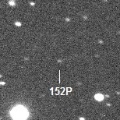
|
Now it is 17.2 mag (May 4, ATLAS South Africa). It will brighten up to 16 mag from spring to summer. It locates somewhat low in the Northern Hemisphere.
Date(TT) R.A. (2000) Decl. Delta r Elong. m1 Best Time(A, h)
May 14 19 57.38 -22 30.8 2.587 3.163 115 16.4 3:19 (341, 30)
May 21 19 58.98 -22 48.1 2.511 3.171 122 16.3 3:12 (345, 31)
|
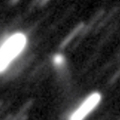
|
Now it is 16.8 mag (May 4, Hirohisa Sato). It was observed at 15 mag in 2021. Now it is fading. It stays observable at 16-17 mag for a while in 2022.
Date(TT) R.A. (2000) Decl. Delta r Elong. m1 Best Time(A, h)
May 14 18 41.74 22 12.1 4.731 5.259 116 16.6 3:16 ( 0, 77)
May 21 18 38.65 23 37.0 4.701 5.280 119 16.6 2:46 ( 0, 79)
|

|
It brightened up to 14 mag in 2021. Now it is fading. Appearing in the morning sky. It is observable at 16-17 mag in 2022.
Date(TT) R.A. (2000) Decl. Delta r Elong. m1 Best Time(A, h)
May 14 0 1.98 4 41.2 6.068 5.483 50 16.6 3:19 (272, 11)
May 21 0 4.84 5 35.7 6.012 5.517 56 16.6 3:12 (274, 16)
|

|
It brightened up to 14 mag from 2020 to 2021. Now it is fading slowly. It is observable at 16.5-17 mag in 2022.
Date(TT) R.A. (2000) Decl. Delta r Elong. m1 Best Time(A, h)
May 14 0 6.07 -14 48.5 4.044 3.622 58 16.6 3:19 (288, -1)
May 21 0 13.01 -14 25.9 3.977 3.640 63 16.6 3:12 (289, 2)
|

|
Now it is 17.9 mag (Apr. 26, J. Drummond). It will brighten rapidly, and it will brighten up to 12 mag from June to July. It stays observable in the morning sky until June.
Date(TT) R.A. (2000) Decl. Delta r Elong. m1 Best Time(A, h)
May 14 23 10.16 4 44.7 1.190 1.158 62 17.5 3:19 (280, 22)
May 21 23 47.04 7 49.9 1.122 1.069 59 16.6 3:12 (275, 21)
|
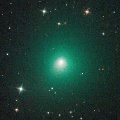
|
It brightened up to 9.5 mag in early summer in 2021 (June 27, Marco Goiato). Now it is fading. It has already faded down to 17.7 mag (May 3, ATLAS Chile). In the Northern Hemisphere, it is not observable until June.
Date(TT) R.A. (2000) Decl. Delta r Elong. m1 Best Time(A, h)
May 14 23 2.46 -31 21.6 4.017 3.963 79 16.7 3:19 (310, 0)
May 21 23 7.89 -31 43.8 3.982 4.022 85 16.8 3:12 (312, 2)
|

|
It brightened up to 14.2 mag in 2021 summer (July 18, 2021, Taras Prystavski). Now it is fading. It has already faded down to 16.2 mag (Jan. 27, SONEAR Observatory, Oliveira). In the Southern Hemisphere, it stays observable in good condition for a long time, although it became extremely low temporarily from March to April. In the Northern Hemisphere, it is not observable until July.
Date(TT) R.A. (2000) Decl. Delta r Elong. m1 Best Time(A, h)
May 14 1 42.50 -27 38.3 5.162 4.610 52 16.7 3:19 (286,-26)
May 21 1 48.27 -27 0.7 5.145 4.647 55 16.7 3:12 (287,-23)
|
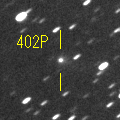
|
First return of a new periodic comet observed at 16 mag from 2003 to 2004. Now it is 16.7 mag (Apr. 22, Ken-ichi Kadota). It will be unobservable in June. But it will become observable again at 17 mag from autum to winter.
Date(TT) R.A. (2000) Decl. Delta r Elong. m1 Best Time(A, h)
May 14 6 53.06 18 0.4 4.606 4.031 49 16.9 20:33 ( 98, 21)
May 21 7 0.61 18 21.0 4.692 4.039 44 16.9 20:41 (102, 15)
|
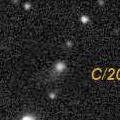
|
Now it is 16.8 mag (May 1, Catalina Sky Survey). It stays observable at 17-18 mag for a long time until 2024.
Date(TT) R.A. (2000) Decl. Delta r Elong. m1 Best Time(A, h)
May 14 13 44.46 2 55.8 7.953 8.825 147 16.9 22:16 ( 0, 58)
May 21 13 40.25 3 19.2 8.018 8.823 140 16.9 21:44 ( 0, 58)
|

|
Appearing in the morning sky. It will be observable at 16.5 mag in good condition from summer to autumn.
Date(TT) R.A. (2000) Decl. Delta r Elong. m1 Best Time(A, h)
May 14 0 33.96 8 9.6 2.758 2.118 42 17.1 3:19 (265, 7)
May 21 0 47.68 9 46.7 2.714 2.123 45 17.0 3:12 (264, 9)
|
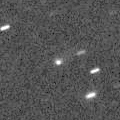
|
Now it is 16.6 mag (May 2, Purple Mountain Observatory). It stays 17 mag for a while.
Date(TT) R.A. (2000) Decl. Delta r Elong. m1 Best Time(A, h)
May 14 13 12.73 -7 32.0 3.830 4.708 146 17.1 21:44 ( 0, 47)
May 21 13 10.68 -7 24.1 3.893 4.708 139 17.1 21:15 ( 0, 47)
|
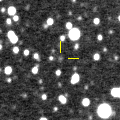
|
Now it is 16.8 mag (Apr. 29, ATLAS South Africa). It will brighten up to 13-14 mag from 2024 to 2025.
Date(TT) R.A. (2000) Decl. Delta r Elong. m1 Best Time(A, h)
May 14 7 22.90 -25 8.6 8.205 7.969 73 17.1 20:33 ( 58, 1)
May 21 7 26.27 -24 48.2 8.236 7.932 69 17.1 20:41 ( 63, -5)
|

|
Now it is 16.5 mag (May 3, V. Nevski). Fading slowly. In the Northern Hemisphere, it stays observable in good condition for a long time. In the Southern Hemisphere, it is not observable after this.
Date(TT) R.A. (2000) Decl. Delta r Elong. m1 Best Time(A, h)
May 14 19 12.22 64 4.6 9.174 9.166 86 17.1 3:19 (186, 61)
May 21 19 6.97 64 58.4 9.174 9.177 87 17.1 3:12 (180, 60)
|

|
It has not been observed yet in this apparition. appearing in the morning sky. It will brighten up to 15 mag in autumn, and it will be observable in good condition.
Date(TT) R.A. (2000) Decl. Delta r Elong. m1 Best Time(A, h)
May 14 23 21.91 -2 39.6 2.740 2.447 62 17.2 3:19 (284, 15)
May 21 23 33.17 -1 37.3 2.643 2.423 66 17.1 3:12 (285, 18)
|
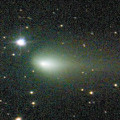
|
It brightened up to 10.6 mag in autumn (Oct. 10, Osamu Miyazaki). Now it is fading. It has already faded down to 16.4 mag (May 5, Catalina Sky Survey). It stays observable in good condition for a long time.
Date(TT) R.A. (2000) Decl. Delta r Elong. m1 Best Time(A, h)
May 14 7 58.40 14 32.2 3.030 2.777 65 17.1 20:33 ( 85, 32)
May 21 8 8.37 14 17.3 3.156 2.820 61 17.3 20:41 ( 89, 27)
|

|
Now it is 17.8 mag (Apr. 22, ATLAS Chile). It stays 17 mag for a long time from 2021 to 2022. In the Southern Hemisphere, it stays observable in good condition for a long time. It is not observable in the Northern Hemisphere.
Date(TT) R.A. (2000) Decl. Delta r Elong. m1 Best Time(A, h)
May 14 6 42.99 -41 13.4 5.660 5.498 75 17.3 20:33 ( 50,-15)
May 21 6 45.06 -41 2.8 5.714 5.511 73 17.3 20:41 ( 54,-21)
|
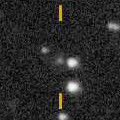
|
Now it is 17.6 mag (May 13, Giuseppe Pappa). It is expected to brighten up to 12.5 mag in winter. It will become unobservable temporarily at 17 mag in July. In the Northern Hemisphere, it will become observable again in October. Then it stays observable in good condition after that. In the Southern Hemisphere, it is not observable at the high light.
Date(TT) R.A. (2000) Decl. Delta r Elong. m1 Best Time(A, h)
May 14 10 30.33 2 43.5 3.350 3.745 105 17.4 20:33 ( 38, 51)
May 21 10 28.32 4 10.8 3.408 3.681 97 17.3 20:41 ( 51, 47)
|
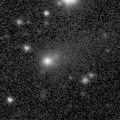
|
Now it is 16.4 mag (Apr. 28, Thomas Lehmann). It will be fading after this, and it will be fainter than 18 mag in June.
Date(TT) R.A. (2000) Decl. Delta r Elong. m1 Best Time(A, h)
May 14 11 28.32 12 18.3 1.907 2.504 114 17.3 20:33 ( 20, 66)
May 21 11 32.34 11 36.1 2.014 2.534 109 17.5 20:41 ( 36, 62)
|
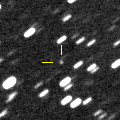
|
Now it is 17.1 mag (Apr. 17, ATLAS South Africa). It will brighten up to 14 mag in 2023. In the Southern Hemisphere, it stays observable in good condition for a long time although it becomes extremely low temporarily in June. In the Northern Hemisphere, it is not observable now.
Date(TT) R.A. (2000) Decl. Delta r Elong. m1 Best Time(A, h)
May 14 6 17.65 -11 40.0 5.293 4.751 52 17.4 20:33 ( 78, -3)
May 21 6 18.67 -11 7.8 5.322 4.707 48 17.4 20:41 ( 83,-10)
|
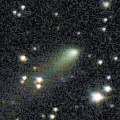
|
It brightened up to 13.9 mag in 2021 (Aug. 28, 2021, Toshihiko Ikemura, Hirohisa Sato). Now it is fading. It has already faded down to 17.6 mag (May 3, Thomas Lehmann). It will be fainter than 18 mag in June.
Date(TT) R.A. (2000) Decl. Delta r Elong. m1 Best Time(A, h)
May 14 11 33.95 39 58.4 3.002 3.347 101 17.4 20:33 (133, 83)
May 21 11 24.25 38 18.7 3.161 3.397 94 17.6 20:41 (107, 75)
|
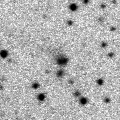
|
Now it is 17.2 mag (May 4, Hirohisa Sato). It started fading before the perihelion passage. It was predicted to stay at 16 mag for a long time. But actually, it will be fainter than 18 mag in autumn. In the Northern Hemisphere, it stays observable in good condition for a long time. In the Southern Hemisphere, it is not observable until 2023.
Date(TT) R.A. (2000) Decl. Delta r Elong. m1 Best Time(A, h)
May 14 0 19.27 78 15.4 4.098 3.759 63 17.5 3:19 (194, 35)
May 21 0 14.98 79 16.2 4.096 3.762 63 17.6 3:12 (193, 37)
|

|
Now it is 16.6 mag (May 3, M. Mattiazzo). It was observable at 16-17 mag in April. However, it will fade out rapidly, and it will be fainter than 18 mag in late May. It is observable in excellent condition in the Southern Hemisphere. It is not observable at all in the Northern Hemisphere.
Date(TT) R.A. (2000) Decl. Delta r Elong. m1 Best Time(A, h)
May 14 6 26.22 -64 59.7 1.386 1.723 90 17.6 20:33 ( 29,-29)
May 21 6 40.54 -59 23.1 1.498 1.760 86 17.8 20:41 ( 36,-29)
|
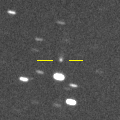
|
Now it is 17.6 mag (May 3, ATLAS Chile). It will brighten up to 16 mag in 2023. In the Southern Hemisphere, it stays observable in good condition for a long time. In the Northern Hemisphere, it is observable only until May.
Date(TT) R.A. (2000) Decl. Delta r Elong. m1 Best Time(A, h)
May 14 9 35.97 -16 31.8 3.853 4.124 98 17.6 20:33 ( 40, 28)
May 21 9 37.08 -16 40.4 3.909 4.085 92 17.6 20:41 ( 47, 23)
|
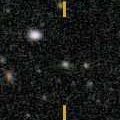
|
Now it is 17.8 mag (Apr. 25, J.-G. Bosch). It is observable at 17 mag from spring to summer. In the Northern Hemisphere, it becomes low in summer.
Date(TT) R.A. (2000) Decl. Delta r Elong. m1 Best Time(A, h)
May 14 11 13.08 24 38.8 1.623 2.130 105 17.7 20:33 ( 48, 75)
May 21 11 15.73 22 13.4 1.675 2.114 100 17.6 20:41 ( 59, 68)
|
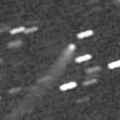
|
It brightened up to 14.2 mag from summer to autumn in 2021 (Sept. 3, C. S. Morris). Now it is 17.4 mag (May 3, Catalina Sky Survey). Fading slowly. In the Northern Hemisphere, it is observable in good condition. It is not observable in the Southern Hemisphere.
Date(TT) R.A. (2000) Decl. Delta r Elong. m1 Best Time(A, h)
May 14 15 23.52 69 54.6 6.910 7.012 91 17.7 23:52 (180, 55)
May 21 15 7.83 69 55.0 6.983 7.050 89 17.7 23:09 (180, 55)
|
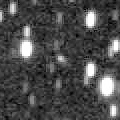
|
Now it is 17.8 mag (Apr. 28, W. Hasubick). It stayed 17.5 mag for a long time in 2021. It will be fading slowly after this. In the Northern Hemisphere, it is observable in good condition. It is not observable in the Southern Hemisphere.
Date(TT) R.A. (2000) Decl. Delta r Elong. m1 Best Time(A, h)
May 14 11 35.73 65 56.2 7.279 7.272 85 17.7 20:33 (175, 59)
May 21 11 33.87 64 50.1 7.355 7.288 82 17.7 20:41 (167, 59)
|

|
Now it is 17.2 mag (May 10, Hirohisa Sato). It stays 17-18 mag until June.
Date(TT) R.A. (2000) Decl. Delta r Elong. m1 Best Time(A, h)
May 14 21 7.65 -22 13.9 1.482 1.935 100 17.7 3:19 (324, 23)
May 21 20 49.55 -19 29.7 1.396 1.987 110 17.7 3:12 (331, 30)
|
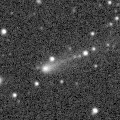
|
It brightened rapidly up to 14.5 mag in winter (Feb. 9, Toshiyuki Takahashi). Now it is fading rapidly. It has already faded down to 18.0 mag (Apr. 29, Mt. Lemmon Survey). It will be fainter than 18 mag in May.
Date(TT) R.A. (2000) Decl. Delta r Elong. m1 Best Time(A, h)
May 14 8 39.74 10 10.2 2.800 2.753 76 17.8 20:33 ( 74, 38)
May 21 8 48.30 9 36.1 2.904 2.771 72 18.0 20:41 ( 78, 32)
|
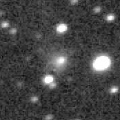
|
It was observed at 16 mag from 2020 to 2021. Now it is fading. It will be fainter than 18 mag in summer.
Date(TT) R.A. (2000) Decl. Delta r Elong. m1 Best Time(A, h)
May 14 22 27.12 15 22.7 6.959 6.683 70 17.8 3:19 (277, 37)
May 21 22 27.08 15 20.5 6.873 6.705 76 17.8 3:12 (280, 41)
|
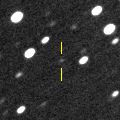
|
Now it is 18.1 mag (May 3, ATLAS Chile). It is expected to brighten up to 12-13 mag from 2024 to 2025.
Date(TT) R.A. (2000) Decl. Delta r Elong. m1 Best Time(A, h)
May 14 9 54.15 -23 46.2 7.560 7.873 104 17.9 20:33 ( 32, 24)
May 21 9 53.23 -22 57.5 7.616 7.829 98 17.8 20:41 ( 40, 20)
|
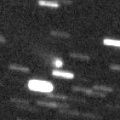
|
Now it is 17.1 mag (Feb. 28, Hidetaka Sato). It was observed at 16 mag from 2020 to 2021. Now it is fading. It will be fainter than 18 mag in May.
Date(TT) R.A. (2000) Decl. Delta r Elong. m1 Best Time(A, h)
May 14 14 7.03 -42 5.2 5.416 6.323 151 17.9 22:38 ( 0, 13)
May 21 13 58.33 -41 43.8 5.477 6.358 148 17.9 22:02 ( 0, 13)
|
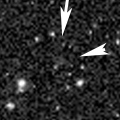
|
Now it is 17.3 mag (May 5, ATLAS Chile). Very far object. It stays 18 mag for a long time from 2021 to 2026. In the Southern Hemisphere, it stays observable in good condition for a long time. In the Northern Hemisphere, it is not observable at all.
Date(TT) R.A. (2000) Decl. Delta r Elong. m1 Best Time(A, h)
May 14 7 27.50 -63 22.2 10.595 10.723 94 17.9 20:33 ( 27,-22)
May 21 7 28.68 -63 0.1 10.605 10.713 93 17.9 20:41 ( 29,-25)
|
|
![]()
 104P/Kowal 2
104P/Kowal 2 C/2022 E3 ( ZTF )
C/2022 E3 ( ZTF ) C/2018 U1 ( Lemmon )
C/2018 U1 ( Lemmon ) C/2020 J1 ( SONEAR )
C/2020 J1 ( SONEAR ) 81P/Wild 2
81P/Wild 2 67P/Churyumov-Gerasimenko
67P/Churyumov-Gerasimenko C/2020 H6 ( ATLAS )
C/2020 H6 ( ATLAS ) C/2020 M5 ( ATLAS )
C/2020 M5 ( ATLAS ) 325P/Yang-Gao
325P/Yang-Gao C/2021 U5 ( Catalina )
C/2021 U5 ( Catalina ) 152P/Helin-Lawrence
152P/Helin-Lawrence C/2020 O2 ( Amaral )
C/2020 O2 ( Amaral ) C/2020 F5 ( MASTER )
C/2020 F5 ( MASTER ) 246P/NEAT
246P/NEAT 169P/NEAT
169P/NEAT C/2020 T2 ( Palomar )
C/2020 T2 ( Palomar ) C/2019 F1 ( ATLAS-Africano )
C/2019 F1 ( ATLAS-Africano ) 402P/2020 Q3 ( LINEAR )
402P/2020 Q3 ( LINEAR ) C/2020 F2 ( ATLAS )
C/2020 F2 ( ATLAS ) 44P/Reinmuth 2
44P/Reinmuth 2 99P/Kowal 1
99P/Kowal 1 C/2021 G2 ( ATLAS )
C/2021 G2 ( ATLAS ) C/2019 O3 ( Palomar )
C/2019 O3 ( Palomar ) 61P/Shajn-Schaldach
61P/Shajn-Schaldach 4P/Faye
4P/Faye C/2020 F7 ( Lemmon )
C/2020 F7 ( Lemmon ) C/2022 A2 ( PanSTARRS )
C/2022 A2 ( PanSTARRS ) 70P/Kojima
70P/Kojima C/2021 X1 ( Maury-Attard )
C/2021 X1 ( Maury-Attard ) C/2020 PV6 ( PanSTARRS )
C/2020 PV6 ( PanSTARRS ) C/2020 U5 ( PanSTARRS )
C/2020 U5 ( PanSTARRS ) C/2022 F2 ( NEOWISE )
C/2022 F2 ( NEOWISE ) C/2021 C5 ( PanSTARRS )
C/2021 C5 ( PanSTARRS ) 100P/Hartley 1
100P/Hartley 1 C/2019 K7 ( Smith )
C/2019 K7 ( Smith ) C/2020 P3 ( ATLAS )
C/2020 P3 ( ATLAS ) C/2022 J1 ( Maury-Attard )
C/2022 J1 ( Maury-Attard ) 110P/Hartley 3
110P/Hartley 3 C/2019 T3 ( ATLAS )
C/2019 T3 ( ATLAS ) C/2022 E2 ( ATLAS )
C/2022 E2 ( ATLAS ) C/2017 Y2 ( PanSTARRS )
C/2017 Y2 ( PanSTARRS ) C/2019 E3 ( ATLAS )
C/2019 E3 ( ATLAS )![]()

























































